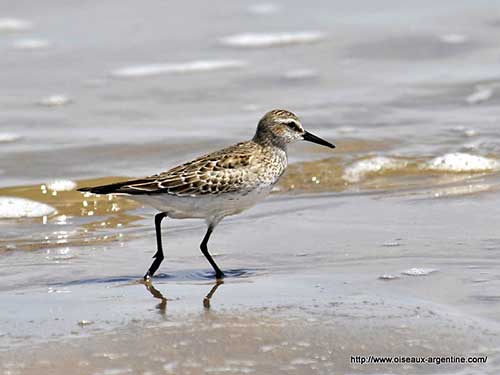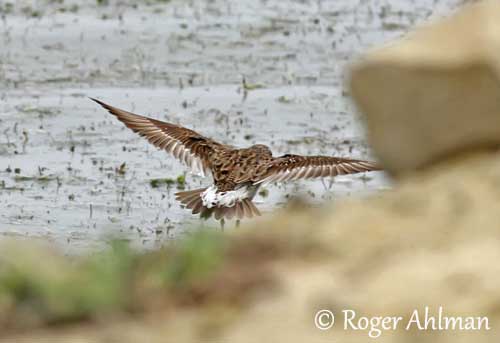
Fr: Bécasseau à croupion blanc – Bécasseau de Bonaparte
Ang: White-rumped Sandpiper
All: Weißbürzel-Strandläufer
Esp: Correlimos Culiblanco
Ita: Gambecchio di Bonaparte
Nd: Bonapartes Strandloper
Sd: vitgumpsnäppa
Photographers:
Roger Ahlman
Pbase Galleries Peru and Ecuador
John Anderson
John Anderson Photo Galleries
Patrick Ingremeau
TAMANDUA
René Lortie
René Lortie photographe & Galeries d'oiseaux sur Pbase
Philippe et Aline Wolfer
OISEAUX D’ARGENTINE
Text by Nicole Bouglouan
Sources:
HANDBOOK OF THE BIRDS OF THE WORLD Volume 3 by Josep del Hoyo-Andrew Elliott-Jordi Sargatal - Lynx Edicions - ISBN: 8487334202
SHOREBIRDS by Peter Hayman, John Marchant and Tony Prater – Christopher Helm – 1986 – ISBN: 0747014035
FIELD GUIDE TO THE BIRDS OF NORTH AMERICA - National Geographic Society -ISBN: 0792274512
All About Birds (Cornell Lab of Ornithology)
What Bird-The ultimate Bird Guide (Mitchell Waite)
Wikipedia, the free encyclopaedia
SORA Searchable Ornithological Research Archive (Blair O. Wolf)
White-rumped Sandpiper
Calidris fuscicolis
Charadriiformes Order – Scolopacidae Family
INTRODUCTION:
The White-rumped Sandpiper is a long-distance migratory species, travelling from Canada’s arctic islands to the southern tip of South America, and even farther to islands lying near the Antarctic Peninsula. This migration is performed in stages of up to 4000 kilometres that can last up to 60 hours.
It nests on the arctic tundra, usually near the coast. On migration and during winter, it frequents a variety of both inland and coastal wetland habitats. It usually occurs in large flocks on the wintering grounds.
The White-rumped Sandpiper is threatened by degradation and habitat loss, and the population is suspected to be decreasing. But currently, the species is not globally threatened.
DESCRIPTION OF THE BIRD:
Biometrics:
Length: 15-18 cm
Wingspan: 36-38 cm
Weight: 28-66 g
The White-rumped Sandpiper in breeding plumage has pale chestnut-buff tinge on crown, ear-coverts and scapular fringes. Shoulder and back feathers are mixed brown and grey. It has white uppertail-coverts (not rump as mentioned in the name of the bird) contrasting with the dark rump and tail.
On the white underparts, neck sides, breast and flanks are pale with brown streaking and spotting.
The standing bird at rest shows long primary tip projection beyond the tip of the tail. In flight, we can see a white band on the uppertail. The male has inflatable throat used during the displays.

On the head, there is a long, whitish supercilium.
The short, slightly dropping bill is blackish, with yellowish to greenish base of lower mandible. The eyes are dark brown. Legs and feet are blackish.
The female is similar but she has slightly larger wings and bill.
The non-breeding adult has dull brownish-grey crown, nape and upperparts, with faint streaks and paler fringes. The supercilium is usually shorter. The underparts are white with greyish-brown wash on breast and upper flanks, and faint grey-brown streaking.
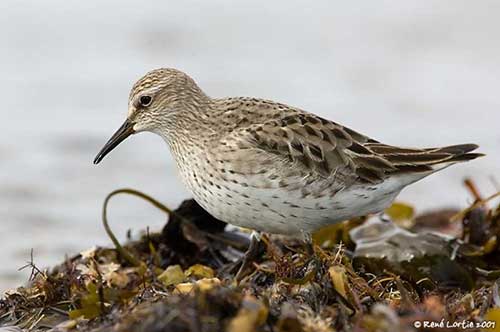
The juvenile resembles adult but it has more brightly coloured upperparts with chestnut fringes and more white tips to feathers. Neck, breast and upper flanks are washed buff-grey and finely streaked. The base of the lower mandible is yellowish-brown.
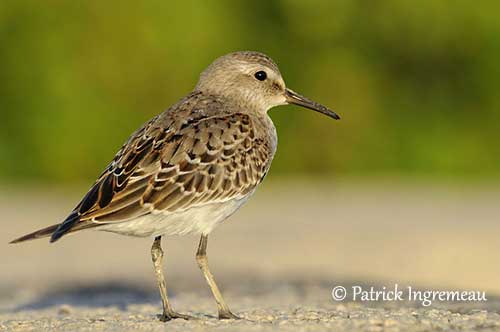
Immature
French Guyana
RANGE:
The White-rumped Sandpiper breeds in N Alaska and N Canada, E to S Baffin Island. It winters in SE South America, from CE Brazil to Tierra del Fuego and Falkland Islands.
HABITAT:
The White-rumped Sandpiper breeds on the arctic tundra, usually near the coast. It nests on the ground in marshy, well-vegetated areas.
On migration and during winter, it frequents a variety of wetland habitats such as beaches and coastal lagoons, riverbanks, freshwater marshes and lakes, wet fields and grasslands.
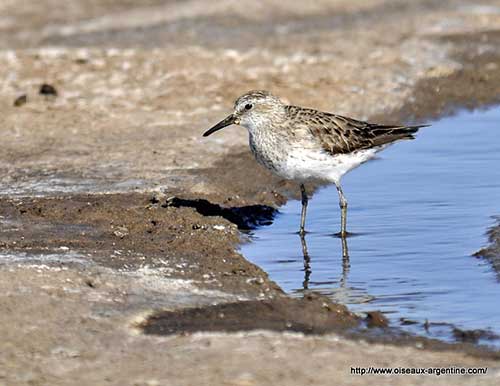

CALLS AND SONGS: SOUNDS BY XENO-CANTO
The White-rumped Sandpiper’s call is a high-pitched, insect-like “jeet” or “eeet”, and a clear, short “tit” or “teep”.
The song given during the displays is usually complex and includes a series of “poing-zee” notes but also various rattles and bubbling sounds. It utters a constant twitter from the ground, or growling and buzzing notes “bzzzzzzzzzzz”.
BEHAVIOUR IN THE WILD:
The White-rumped Sandpiper feeds on small invertebrates including insects, mollusks and marine worms. Insects are mainly caught during the breeding season. On migration and during winter, its diet includes insects, snails, marine worms, crustaceans and leeches. Seeds and other plant material are also consumed.
It forages in wet areas by probing in mud or shallow water. It also picks up food items from the surface. On the breeding grounds, it probes deeply in moss and vegetation.

The White-rumped Sandpiper is polygynous. It starts the displays at the beginning of the breeding season. It performs aerial displays over the breeding territory and extends its highly inflatable throat while fluttering, hovering and gliding, and produces rattling sounds. The female may sometimes participate to these displays.
On the ground, the male stretches the wings out to side and raises the tail to display the white uppertail-coverts. It walks and runs while calling repeatedly.
The White-rumped Sandpiper is a very long-distance migrant. It leaves the wintering areas in March/mid-April and reaches N South America in late April/mid-May and the northernmost breeding grounds in early June.
It leaves the breeding grounds in early August and reaches S South America in November/December.

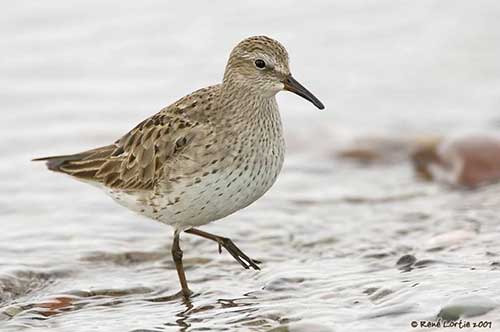
It is regularly reported in Falklands and South Georgia, and may occasionally reach Antarctica. It is vagrant in Spitsbergen, Franz Josef Land, Austria, Germany, Switzerland and Spain, and especially on British Islands and many other locations, including Australia and New Zealand.
The White-rumped Sandpiper has strong, powerful and direct flight, performed with rapid wingbeats.
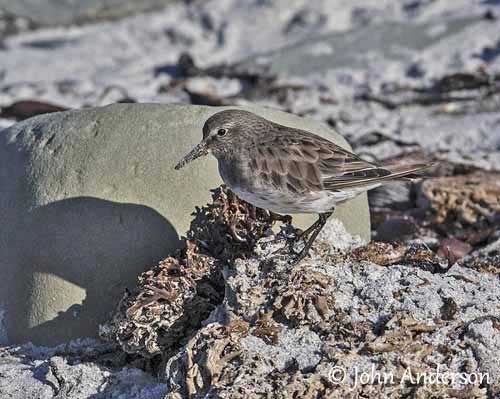
REPRODUCTION OF THIS SPECIES:
The breeding season takes place between June and August. The White-rumped Sandpiper nests solitary, and the male defends strongly the territory during the egg-laying. The nests can be placed from 12 to 475 metres apart (rarely 12 metres).
The nest is on the ground in the wet tundra with grass and dwarf willows. It is well-hidden in a clump of grass or moss. The female builds a cup-shaped depression lined with moss, lichen and leaves, but this material is sometimes naturally present on the ground.
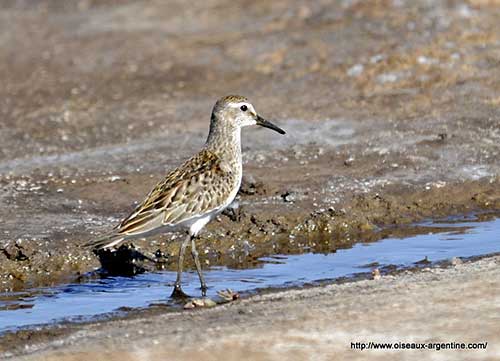
The female lays 3-4 greenish/buff eggs with darker markings. She incubates alone during 3 weeks. The male leaves the territory soon after the egg-laying. The chicks are precocial and leave the nest within 24 hours after hatching. The female tends and broods them, but the young are able to feed themselves. They fledge 16-17 days after hatching and are independent very soon. This species produces a single clutch per season.
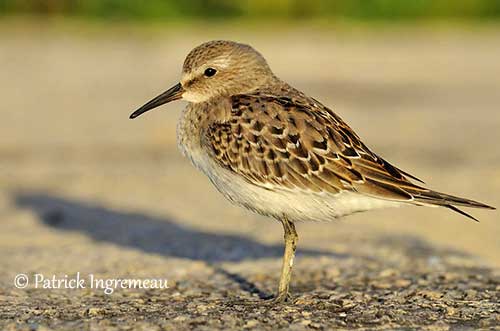
Immature
French Guyana
PROTECTION / THREATS / STATUS:
The White-rumped Sandpiper suffers nest predation by skuas, arctic foxes, Peregrine Falcon, Glaucous Gull, Common Raven and Sandhill Crane on the breeding grounds.
The species is threatened by degradation and habitat loss. The population is suspected to be decreasing. But currently, the White-rumped Sandpiper is evaluated as Least Concern.
